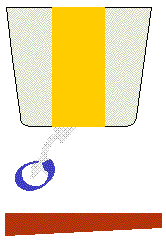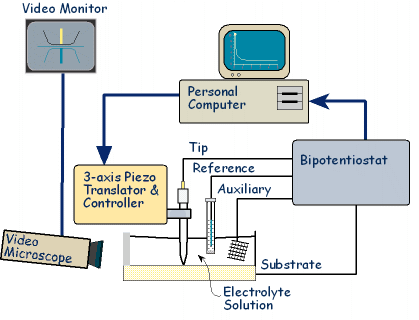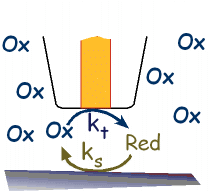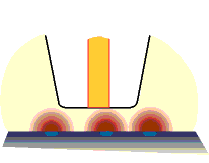 Scanning Electrochemical
Microscopy
Scanning Electrochemical
Microscopy Scanning Electrochemical
Microscopy
Scanning Electrochemical
Microscopy
The scanning electrochemical microscope (SECM) is a scanned probe microscope (SPM) related to the familiar scanning tunneling and atomic force microscopes. All SPMs operate by scanning or "rastering" a small probe tip over the surface to be imaged. In SECM, imaging occurs in an electrolyte solution with an electrochemically active tip. In most cases, the SECM tip is an ultramicroelectrode (UME) and the tip signal is a Faradaic current from electrolysis of solution species. Some SECM experiments use an ion-selective electrode (ISE) as a tip. Two features distinguish SECM from related methods such as electrochemical STM or AFM: the chemical sensitivity of the SECM tip and the use of solution phase ions or molecules as the imaging signal.
[index]

SECM Block Diagram
The SECM uses piezoelectric based positioners (Inchworm® motors, Burleigh Instruments) to position the tip in any of 3 axes at scan speeds from 0.05 to 1000 µm/s, although 1 to 20 µm/s is a more typical scan rate. In addition the postioners allow movements of less than 0.1 to 300 µm during SECM images. The tip and substrate potential must often be simultaneously controlled and the Faradaic current flow monitored during imaging. This is aided by use of a bipotentiostat. Hardware on the personal computer supplies control signals to the piezo-positioner and collects data from the tip and substrate. A video microscope is useful to observe the tip electrode as it approaches the substrate.
[index]
Undoubtedly, the most crucial component of the SECM is the tip. A commonly used tip is based on an embedded disk-shaped geometry.

Disk-type SECM Tip
Disk-shaped tips are usually made by heat sealing microscopic wires (usually gold, platinum, and carbon) into glass tubes. The end then polished to expose an embedded disk. The tip must then be ground so that the glass insulator forms a truncated cone. This allows the tip to approach more closely the substrate surface. A typical disk electrode would have a radius, a, of 1 to 25 µm. An insulator radius of 3 to 10 times larger than the electrode radius (the RG ratio) is desirable.
[index]
A requirement of SPM techniques is that the signal from the tip must be perturbed in some reproducible fashion by the presence of the surface of the material being observed. The two major imaging methods are the Feedback or Generation/Collection (G/C) methods.
[index]
The unique voltammetric response of ultramicroelectrodes, or UMEs, are an essential part of the SECM Feedback or G/C methods. Shown below is a CV of the ion Ru(NH3)63+ at a 10-µm diameter tip in an unstirred buffer solution.
The sigmoid shape of the wave indicates the the current reaches a steady state in which the current is independent of time. The value of the steady-state limiting current, iT,∞, for a micro-disk electrode embedded in an insulator is given by the following equation (click on the variable to get a definition).
[index]
Feedback imaging uses the Faradaic current that flows from the electrolysis of a mediator species (e.g. ferrocene or Ru(NH3)63+) at the UME tip as a probe of a substrate surface. The surface perturbs the tip signal in a characteristic way for electronically insulating or conducting surfaces.
[index]
Positive Feedback is illustrated by the following two animations. The Feedback process occurs when the mediator is restored to its original oxidation state at the substrate by an electrochemical, chemical, or enzymatic reaction. As the gap width, d, decreases the regeneration of the mediator tip-substrate gap becomes more efficient and the current, IT, increases.
[index]
Negative Feedback occurs by the physical blocking of diffusion of mediator molecules to the tip electrode by the surface. This produces a drop in tip current, IT, with a decrease in gap width, d, as illustrated below.
[index]
 Postive and negative feedback modes are
limiting situations in which the rate of electron transfer from the substrate to the
mediator is rapid (above the diffusion limit) and very slow, respectively, In the general
case the rate may lie between these extremes. A unique advantage of the SECM is the
ability to design experiments in which the chosen mediator can be used to provide chemical
and electrochemical activity maps at micron and submicron resolution.
Postive and negative feedback modes are
limiting situations in which the rate of electron transfer from the substrate to the
mediator is rapid (above the diffusion limit) and very slow, respectively, In the general
case the rate may lie between these extremes. A unique advantage of the SECM is the
ability to design experiments in which the chosen mediator can be used to provide chemical
and electrochemical activity maps at micron and submicron resolution.
In reaction-rate feedback, the imaging conditions are manipulated so that the overall mediator turnover rate at the substrate is limited by the rate of substrate-mediator electron transfer rate, ks. Experiments have demonstrated that the microscope can be used to map variations in electron-transfer rate at metallic electrode surfaces and enzymes in biological materials.
In addition, the SECM can be used to determine electron transfer rate constants of a chosen mediator by observation of the tip current as a function of tip-substrate separation and by tip, kt, and substrate, ks,electron transfer rates.
[index]
 In the generation/collection (GC) mode, the
tip signal arises from a species generated at the surface of the imaged material. Ideally,
the tip acts only as a passive sensor with the ability to produce concentration maps of a
particular chemical species near the substrate surface. In amperometric GC, the
electroactive species emitted, "generated", by the substrate are detected,
"collected", by electrolysis at an UME tip. The first
reported use of the method was to map electrochemically active areas on electrodes . GC
SECM has been used to make high-resolution chemical concentration maps of corroding metal
surfaces, biological materials, and polymeric materials. In addition, spatially resolved
quantitative measurement of ion flux through porous material such as mouse skin and dental
material can be made. Potentiometric GC mode uses an ISE tip, which has
the advantages of minimizing perturbation of the diffusion layer, sensitivity to
non-electroactive ions, and selectivity for the imaged ion. Images have been made of pH,
Ca2+, NH4+, etc.
In the generation/collection (GC) mode, the
tip signal arises from a species generated at the surface of the imaged material. Ideally,
the tip acts only as a passive sensor with the ability to produce concentration maps of a
particular chemical species near the substrate surface. In amperometric GC, the
electroactive species emitted, "generated", by the substrate are detected,
"collected", by electrolysis at an UME tip. The first
reported use of the method was to map electrochemically active areas on electrodes . GC
SECM has been used to make high-resolution chemical concentration maps of corroding metal
surfaces, biological materials, and polymeric materials. In addition, spatially resolved
quantitative measurement of ion flux through porous material such as mouse skin and dental
material can be made. Potentiometric GC mode uses an ISE tip, which has
the advantages of minimizing perturbation of the diffusion layer, sensitivity to
non-electroactive ions, and selectivity for the imaged ion. Images have been made of pH,
Ca2+, NH4+, etc.
[index]
In the "direct" mode, the tip is a counter electrode to the substrate electrode, permitting substrate electrochemical reactions at a small region of approximately tip size. Deposition of metal and polyaniline lines as thin as 0.3 µm has been reported using the direct mode.
[index]
In addition to imaging, the SECM tip can be a microscopic source or sink of electrons and chemical reagents. With the tip positioned close to surface, these reagents perform modifications to surfaces on a microscopic scale, turning the SECM into a versatile microfabrication device. In the micro-reagent mode, a reaction at the SECM tip changes the local solution composition to provide a driving force for chemical reactions at the surface. Electrolytic generation of an oxidizing agent at the SECM tip can precisely etch metal and semiconductor surfaces and local pH changes caused by electrolysis at the SECM tip have been used to deposit metal oxides and polymers.
[index]
| AFM | atomic force microscopy |
| bipotentiostat | An instrument that maintains simultaneous constant potential control of two working electrodes versus a reference electrode. Also, acts as a current transducer for the working electrodes. |
| CV | cyclic voltammetry |
| C | concentration of redox species |
| D | diffusion coefficient of redox species |
| ET | electron transfer |
| F | the Faraday |
| Faradaic | electron transfer leading to a chemical transformation |
| GC | generation/collection mode of the SECM |
| a | radius of the tip electrode |
| d | distance beween tip and substrate |
| ISE | ion-selective electrode |
| iT,∞ | steady-state limiting current current of the tip electrode at infinite tip-substrate separation |
| IT(L) | normalized tip current at the normalized distance L |
| IT,ins(L) | normalized tip current over an insulator at the normalized distance L |
| IT | normalized tip current, iT/iT, ¥ |
| k | heterogeneous rate constant |
| L | the normalized distance from tip to substrate, d/a |
| n | number of electrons transferred in a redox event |
| Ox | a mediator in an oxidized state |
| Red | a mediator in a reduced state |
| RG | ratio of the insulator radius to the disk electrode radius |
| SCE | saturated calomel electrode |
| SECM | scanning electrochemical microscope, scanning electrochemical microscopy |
| SG/TC | substrate generation/tip collection mode of SECM |
| SPM | scanning probe microscopy |
| STM | scanning tunneling microscopy |
| Substrate | the stationary electrode in the SECM setup |
| Tip | typically the electrode that is rastered on the SECM |
| TPM | tip position modulation |
| UME | Ultramicroelectrodes have at least one characteristic dimension of micrometer size. The most common type has an embedded disk geometry. Other common geometries are hemispherical, conical, or band shaped. |
[top]
Copyright © 2011 David O. Wipf All rights reserved.
David O. Wipf wipf@ra.msstate.edu Last updated April 7, 2011 "The views and opinions expressed in this page are strictly those of the page author. The contents of this page have not been reviewed, approved or monitored by Mississippi State University."